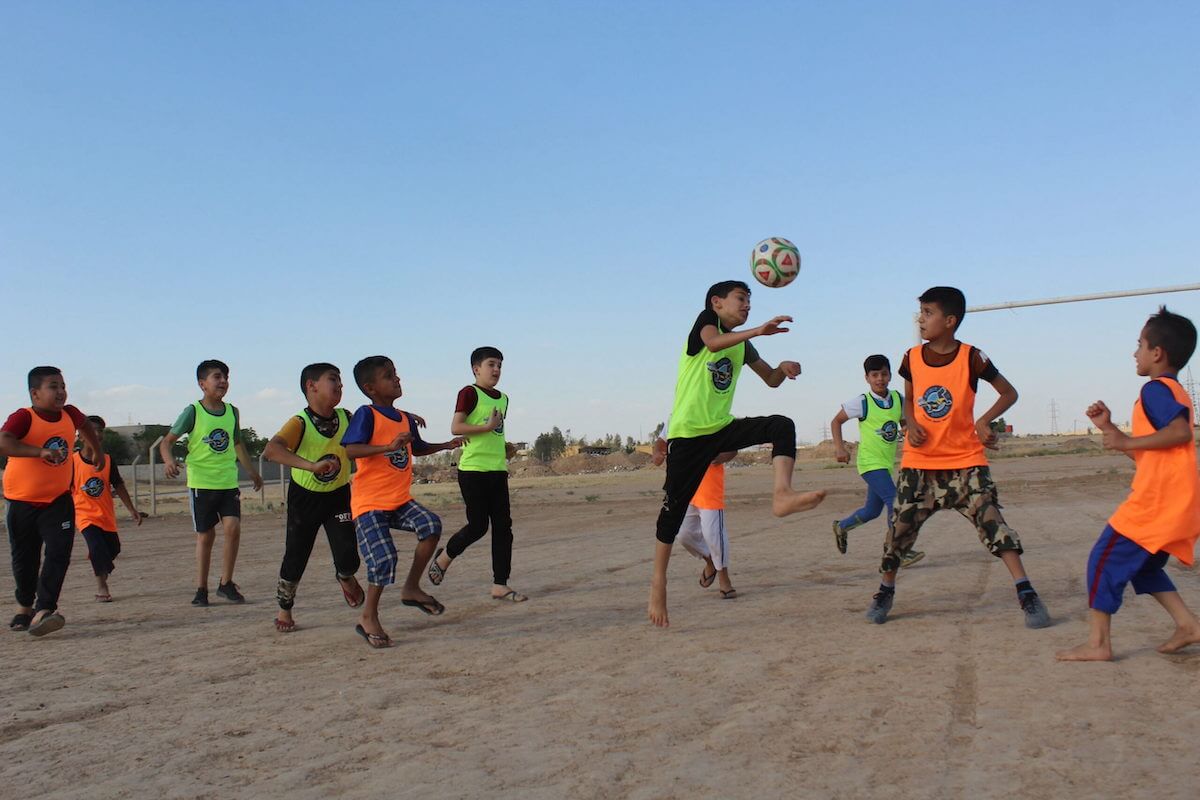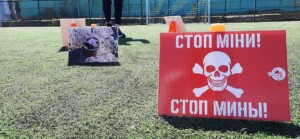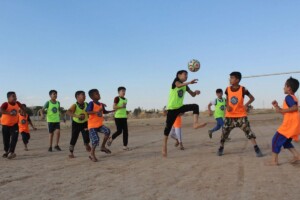How did someone who grew up playing football in the relative safety of the council housing estates of Hatfield north of London, find his purpose by taking the game to some of the most inhospitable and dangerous places in the world? We spoke to Spirit of Soccer Founder, Scotty Lee, to discover why being in the wrong place at the right time prompted him to action.
“For me, football is life,” Scotty says. Apt words, as the A-licence accredited football coach has been using the sport for the past 23 years to improve, and often save, the lives of people in conflict and post-conflict zones around the world. In 1996, Scotty founded Spirit of Soccer to educate people about the dangers of Explosive Remnants of War (ERW), landmines and Unexploded Ordnances (UXO).
Scotty’s first experience of armed conflict was in 1993, when he was driving humanitarian aid convoys through the Balkans that were embroiled in a bloody civil war. “During that time, I had been shot at, shelled, had experienced people laying anti-tank mines in the road,” he remembers. Having ventured into the line of fire without any prior military training, the assignment challenged him both physically and mentally. Nevertheless, he was drawn back to the region when, in 1996, he was hired by Arsenal in the Community to deliver a football coaching programme. He “hitched a lift” with an Edinburgh Direct aid convoy bound for Sarajevo.
One day, Scotty heard about a tragic event involving a group of young children. They had been playing football in a suburb of the Bosnian capital close to the front line, when the ball rolled into the undergrowth. The young players followed in hot pursuit not noticing a tripwire in their path. A fragmentation mine was set off, killing them all instantly.
Shaken by this incident, Scotty became determined to prevent it from being repeated. An idea formed in his head: he could turn the fact that children will play football even in the most hostile circumstances into an advantage. He would use the game to teach them important lessons about how to stay safe. “At the time there was no mine risk education,” Scotty explains, then ponders his response, adjusting his previous sentence to clarify: “Well, mine risk education was: guys in uniforms with guns showing kids defused weapons.”
Scotty marched to the nearest United Nations office and asked the staff to give him information about the weapons used in the conflict. With this knowledge, he began drawing up training sessions. At the time, Sarajevo was a city with fresh wounds from an almost 4-year siege. The buildings were pockmarked from gun shells, there was no electricity, no running water, but the shooting had stopped. Scotty made his way to one of the football grounds where he would start training. He found it littered with landmines. It was an unfortunate but unsurprising episode for a Mine Risk Education programme. Scotty was unperturbed. “There are only solutions, there’s never a problem,” he says, an approach which he has maintained throughout his career. He found local experts to demine the pitch and resumed his plans.
Scotty began travelling around, visiting every football club he could locate and coaching daily. At the time, “peace was very fragile,” he remembers. Getting access the different parts of the country was not easy, particular for a “Westerner”. It was football that granted him that access.
His personal life briefly took him to the United States, where he got married, but Scotty was soon to return to the region.
Having established ties with the US State Department’s Office for Weapons Removal and Abatement, which delivers programmes and services to reduce the harmful effects of at-risk, illicitly proliferated, and indiscriminately used conventional weapons of war, he secured funding for a Mine Risk Education programme in Kosovo.
Scotty arrived in 1999, only two weeks after the fighting had ended. The situation there was completely different from what he had experienced previously in the region, Scotty recalls. When he had been in Bosnia, he had taken “calculated risks” bringing teams together under the umbrella of Spirit of Soccer. In Kosovo this wasn’t possible. In Mitrovica, the city in northern Kosovo where he was now working, he coached Kosovars in the morning, then crossed the bridge spanning the river Ibar and trained with two Serbian clubs in the afternoon. “I couldn’t tell the difference,” Scotty says. ‘You look like the people across the river’, he thought to himself. While both sides remained at a geographically supported distance, they welcomed him with equal measures of hospitality. “I would rock up, bring some footballs – so I was a bit of good news for them,” he reflects.
After Kosovo came a turning point in the development of Spirit of Soccer as an organisation. “The biggest evolution after Kosovo,” Scotty says, “was transferring my skills to other people and increasing capacity.” Up until then, Spirit of Soccer had only consisted of Scotty and his assistant coaches. The change was prompted when Spirit of Soccer began working in Cambodia. “I started training other people, because I knew I wasn’t going to live overseas.”
Previously, he had been based in Sarajevo. In Kosovo, he had stayed in the country for three months at a time, only returning to his family in the US for one-month intervals. “It was like being in the army,” he admits. Scotty set about both growing the organisation and making it more sustainable, which would also enable him to spend more time with his wife and children. “I didn’t want to spend all my time away and miss the kids growing up,” he says.
Creating more capacity meant generating greater funding to enable Spirit of Soccer to employ other people to carry out the projects. In 2003, Scotty managed to acquire a substantial grant from the US State Department and seal a partnership that has lasted ever since. As a consequence, Scotty could take the methodology he had developed over the past years to other parts of the world. “We have a very strong template,” he says, listing the four pillars of Spirit of Soccer’s Mine Risk Education programme: “Keep Away, Don’t Touch, Report and Communicate.”
“These elements of team work, risk and communication – they are all parts of football,” Scotty comments. “I have created technical and tactical skill drills that replicate communication: keeping the ball, keeping it away from certain areas, et cetera.” While this template allows Scotty and his team to set up programmes in new places easily, he says that the local coaches are encouraged to adapt it and add a “regional flavour”.
When Scotty arrived in Cambodia in 2005, landmines and explosive remnants of war were killing around 1000 people each year. Spirit of Soccer began running Mine Risk Education programmes in Battambang and Kampong Chhnang provinces in cooperation with the Cambodian Ministry of Education, Youth and Sports (MOEYS), the Cambodian Football Federation (FFC) and the National Mine Action Agency (CMAC). Establishing these ties, as well as a regional office with local coaches helped to ensure that the programme would run long term.
Gaining credibility by working with the communities in question and offering locals a livelihood is of great importance to Scotty. By gathering expertise in one country, Scotty says, it then became possible to expand further into the region. “Our coaches from Cambodia helped us set up in Laos,” Scotty says, explaining that, “Coaches from one region with similar cultures can see what someone else from further afield might miss.”
Mine Risk Education proved to be more than just a mission in itself: “It gave me the opportunity to develop grassroots football in war zones,” Scotty comments, “It gave me the opportunity for coaches’ education. I knew how valuable it is after two decades as an “A” licenced instructor from two continents, to promote ‘Coaches Education’. These courses increased my learning power, increased my confidence, increased my standing. So, I’m like, ‘If it can do it for me, it’s going to do it for my coaches.’”
Not only observing the effects of the programmes, but how the coaches he has trained to deliver them flourish, is one of his greatest sources of motivation. ”Seeing how proud they are of what they’re doing: Saving kids from weapons used in wars that they have experienced themselves,” Scotty says, his usual jovial tone becoming earnest, “What motivates me is my staff.”
At the behest of the US State Department, Scotty found himself on his next mission in 2007 to one of the most dangerous places in the world: Iraq. At the height of the insurgency, it proved a risky visit. “I spent five days of the two weeks under intensive shelling,” Scotty says.
It took time and much perseverance to gain a foothold for Spirit of Soccer programmes in Iraq. Since their first launch in 2009, 300 coaches have been trained in Mine Risk Education reaching almost 300,000 children to date. Here, again, Scotty reports, the emphasis was on training locals and ensuring the coaches hailed from Arab, Sunni, Shia, Kurdish and Christian communities.
Due to the nature of the conflict in Iraq, Scotty recognised the need to expand his programmes. The conflict had not only left weapons and explosive devices in its wake, but a large number of young men with no occupation or purpose. “When you’ve got a lot of men with nothing to do, that equals danger and problems,” Scotty explains. Spirit of Soccer devised a football-based programme within the ‘Countering Violent Extremism’ (CVE) framework to provide these young men – so-called “fighting age males” between the ages of 18 and 40 – with training opportunities and access to regular football activities. “It gives them something to look forward to. Their lives are shit in the refugee camps where Daesh are recruiting every day. But if you can give someone a bit of hope, a bit of positivity, for them to unleash the bit of energy they’ve been holding in, through positive activity, exertion, exercise, it has a profound effect.” So far, 11,722 young men throughout Iraq have become part of the programme.
Most recently, in 2015, Scotty and his team began working in Colombia, a country scarred by decades of civil war. According to the Spirit of Soccer website, Colombia has “one of the highest incidences of child casualties from landmines and Explosive Remnants of War (ERW) in the world.” Not surprisingly, for many of these weapons directly targe children with explosive devices planted in schools and even inside toys and footballs. This, for Scotty, exemplifies the changing nature of conflict and warfare all over the world: soldiers have long ceased to be the only victims of war; civilians are an ever-more direct and intentional target. Commenting on civilian casualties dismissed as an unavoidable consequence of conflict, Scotty states emphatically: “There is no such thing as collateral damage,” adding with brutally clear words, “There are just dead people.”
The very nature of his work means challenges are predetermined from the outset. “You don’t lay mines in good places,” Scotty notes sardonically. “You’re not dealing with nice people all the time.” To be able to do his job, he says: “You’ve got to be flexible, the game plan always changes. I expect the best and plan for the worst.” He admits that he also finds the challenge fulfilling: “I enjoy getting through war zones without being armed. Just the ball and my team.”
What has helped him stay on track over the years? “Single-mindedness,” he replies without needing a moment to reflect. “I focus on two things: one, the developmentof football and two, making sure these kids stay alive. When you’re that single-minded, you don’t get distracted. Also, the continuing faith shown in us by the US Government. Too often in the Sport for Development and Peace sector, funders only give grants for a year here and six months there – this is a completely unsustainable approach and doesn’t help anybody. Having a partner who supported us for multiple years has allowed us to build trust, employ locals and scale our impact more effectively.”
Not erring from the path and staying focused is not always easy considering the circumstances of the work Spirit of Soccer does. “When you’re on the front line,” Scotty reflects, “you get close to people very quickly.” This, of course, also has its advantages: “You’re not fighting for a flag, you’re fighting for the person next to you. It creates very strong bonds.” As in football, overall success corresponds to the strength of the team. Scotty notes the many parallels between football and war, not without a hint of sombre irony in his voice that many, in fact, aid his work.
“The two things you’ve got to realise about football and war is they’re multi-billion dollar industries,” he begins, “And the other thing: they’re indiscriminate.” He pursues the thought further to proffer a comparison between football and landmines: “Football has no eyes, it doesn’t know what colour you are, it doesn’t see what gender you are, it doesn’t see what religion you are. It’s for everybody and can be used by anybody. And so is a mine. It doesn’t matter if you are a toddler or a ninety-year-old man and you step on an anti-personnel mine and have your legs blown off,” Scotty says. “I think that one of the reasons why Spirit of Soccer works so well is that both things that we are involved with – the mine and football – are indiscriminate.” A very significant difference, of course, is that: “With football you get a second chance, with mines you don’t get a second chance.”
So, is football the second chance for people living in the midst of conflict? Can football save the world? “No,” is Scotty’s laconic response. He rephrases the question: “Is football a tool that we can use to help us? – Yes.” Using this tool, the Spirit of Soccer coaches reach some 100,000 children each year. “So, basically, I’ve got my own mob,” Scotty laughs. “But instead of picking up guns, we pick up footballs.”







